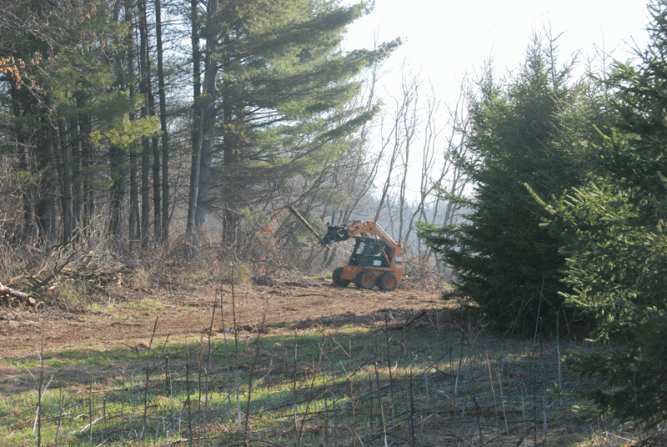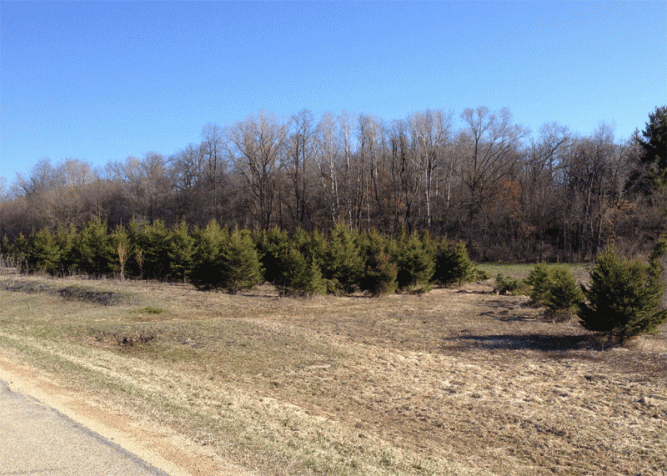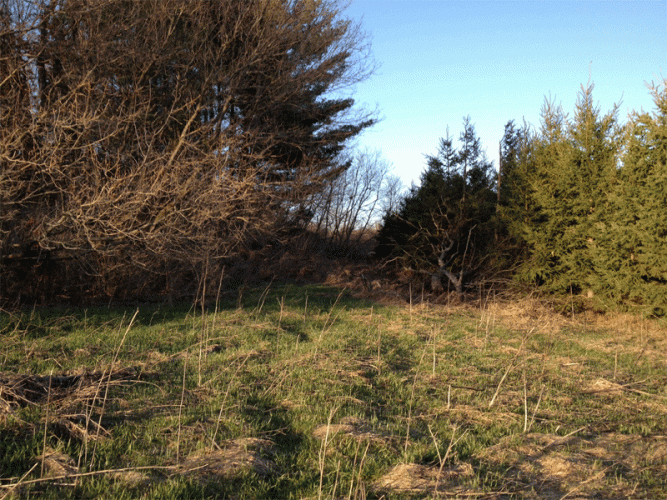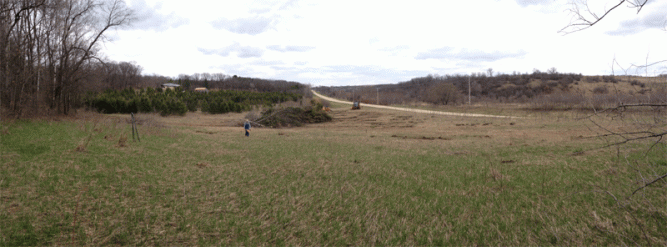We have been dreaming about growing grapes on our south-facing slope for many years. Now the rubber is starting to meet the road. Or rather, the caterpillar treads are starting to meet the ground.
 When we walked the site with Judy Reith-Rozelle, our grape consultant, we learned that there is more to an ideal site for a vineyard than simply south facing.
When we walked the site with Judy Reith-Rozelle, our grape consultant, we learned that there is more to an ideal site for a vineyard than simply south facing.
She noted that our site not all the way to the top of the south-facing slope. That means cold air falling down the hill and threatening our grapes.
It’s always cooler in the bottom of the valley. My best friend, who lives in a sweet, old Victorian farm house nestled deep in a valley named her place Frost Pocket Farm.
Judy looked down from the vineyard site at a clump of about 100 spruces at the bottom of the valley and said they would have to go. The cold air falls down the hills, pools up against the spruce barrier and then fills back up into the area where our tender young grapes would be shivering.
 The worst part of the frost is before the grapes have leaves on them. All you have is the bare cordons. What you are concerned about is when the buds start to break in early spring. You can get really bad frost damage, and also when the flower clusters are just starting to open is another frost danger zone.
The worst part of the frost is before the grapes have leaves on them. All you have is the bare cordons. What you are concerned about is when the buds start to break in early spring. You can get really bad frost damage, and also when the flower clusters are just starting to open is another frost danger zone.
That’s why the cold air can fall safely down through the rows of vines. They haven’t leafed out to form a barrier that would trap the chill, and by the time they leaf out, the weather is no longer fatally cold.
Judy suggested we replace the spruce “dam” with a pollinator-friendly prairie.
Then she turned east toward the clump of trees growing out from our northern border just beyond the vineyard site.
“I’m looking at those trees,” she said. “You could open it up to more sun.”
She looked west. The sumacs growing there would block western breezes blowing through the rows of grapes which help keep them from getting too damp and being vulnerable to mildews.
Doug and I were feeling overwhelmed. We have cleared small areas for prairie and savanna by ourselves, but the scope of this project was beyond our power.
We turned to Bruce Lease, the man who has done all the excavation for our lane, our barn and our house. When Bruce climbs up into the cab of his back hoe he becomes one with the machine. It’s always been amazing to watch him work. He knows what can and can’t be done. He knows what should and shouldn’t be done based on an almost intuitive sense of the lay of the land.
 It was the work of a morning for Bruce to transform the spruce stand into the beginning of a bonfire. Since then, Doug and Bruce have been working together. Doug has been felling the trees around the edge of the clump on our northern border just to the east of the vineyard site. This area is one of those spaces where no one has cared what grew there for decades. It was too steep to plow for agricultural use and was left to itself.
It was the work of a morning for Bruce to transform the spruce stand into the beginning of a bonfire. Since then, Doug and Bruce have been working together. Doug has been felling the trees around the edge of the clump on our northern border just to the east of the vineyard site. This area is one of those spaces where no one has cared what grew there for decades. It was too steep to plow for agricultural use and was left to itself.
What grew there was a crowded mishmash of pines, cherry, oak, and mostly box elder.

These are trees, that if we had known what we know now — we would have cut out with a loppers 10 years ago.
The box elders made a place for themselves by wrapping themselves around the straighter trees and then growing out from the clump at 45% angles.
The hardwoods were crowding each other so closely that felling them proved very tricky. In one case, a cherry and oak seemed to have bonded over about 8 feet of their length. When we finally got that cherry down, the center was completely rotted out in the area where they had been fused.

There goes one of the taller box elders. I can’t even imagine how long it would have taken Doug and I to clear the vineyard site with our own strength and a chain saw alone. Bruce was trying out a new piece of equipment that grabbed the trees by the trunk, and even an old hand like him was impressed.
Our karma is taking on the lives of so many trees for this project, but I believe that when the sawdust settles, there will be a much more sustainable environment in place.
Our goal to grow seedless raisins and be part of the local foodshed seems worthwhile. And we are replacing 100 spruce that were planted too close together and for which there is now no market so we could never afford to thin them with a pollinator-friendly prairie (we plan to use the seed mix just developed by Xerces Society ) and sold by Prairie Nursery. The new planting will help provide habitat for endangered native pollinators – and they are endangered.
It’s taken a lot of soul searching and petroleum-powered brute force to make these dramatic changes to several acres of our land.
We hope we will look back, weigh it all in the balance and be glad we did.
Categories: Uncategorized







I feel your pain 🙂 Ian was out yesterday with a grader to flatten wild boar (hog) damaged areas and also to flatten the damage we have done to the land through putting in an electric cable and the winter damage on the road way. Hopefully when it greens up, it will look much better and I know from our previous work on our forest, yours will be much healthier in a year or two.
Yes, it’s quite a shift of mindset from trying to do everything in our yards with our own muscle power (little push reel mower, etc.) and trying to care for 44 acres – and turn land that has been left to itself for some time and become quite naturalized (or had spruces planted on it) back into a place that can provide food for the community and some small income for us.
Ultimately, I hope the scales will weigh out on the plus side, but we are entering new territory – literally and figuratively.
Lots of work for those little grapes! My grandparents had grapevines. I loved picking (and eating) grapes every summer. Too bad I was a bit young to enjoy the wine they made.
My grandparents both had grapevines too, on a small scale. I remember the single row of grapes that ran along the side of the yard and acted as a border between us and the neighbors. At the end was a little bower where the grapevines created an enclosed space with a bench. I always thought the grapes tasted especially good picked and eaten in that bower. I wish I could ask my grandmother about when she planted her grapes. They were just part of a well-rounded garden back then, I think.
My grandparents were Methodists and lived in a dry county in central Illinois. There was no thought of wine there – just some amazing grape jelly. I’m looking forward to trying to duplicate that.